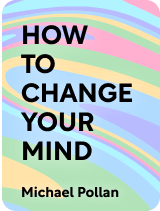

This article is an excerpt from the Shortform book guide to "How to Change Your Mind" by Michael Pollan. Shortform has the world's best summaries and analyses of books you should be reading.
Like this article? Sign up for a free trial here.
What are the best How to Change Your Mind quotes? Do magic mushrooms and LSD have the potential to solve the world’s problems?
While there are some negative effects of taking psychedelics, How to Change Your Mind by Michael Pollan asserts that there are some benefits you don’t know about. This includes the improvement of mental health and the current environmental crisis.
Below we’ve listed three quotes from How to Change Your Mind that explain Pollan’s main ideas.
Quotes From How to Change Your Mind
Did magic mushrooms contribute to making us human? In How to Change Your Mind, Michael Pollan traces the long and complex history of humans’ relationship with psychedelics and examines their potential use for mental health treatment today. He delves into the complex legal and cultural issues surrounding psychedelics and considers what their re-emergence might mean for our society as a whole.
Michael Pollan is an author, journalist, and professor. He is best known for his books The Omnivore’s Dilemma and In Defense of Food, which have helped shape the public’s understanding of the modern food system. But after learning about terminal cancer patients who were given psilocybin to help ease the fear of death, Pollan threw himself into research on psychedelics—which included personal experimentation.
Here are the best How to Change Your Mind quotes that you should remember.
“Normal waking consciousness feels perfectly transparent, and yet it is less a window on reality than the product of our imaginations-a kind of controlled hallucination.”
In the course of research for this book, Pollan decided to undertake his own personal experimentation with psychedelics. As an American man in his 60s, he’d long been aware of psychedelics but had never tried them. After interviewing dozens of people, and hearing so many stories of transformation, healing, and realization, Pollan was driven to see if he could also derive some benefit from these substances. He knew this would be the only way to truly understand the subject. So he confronted his fears and used his connections from this book’s research to arrange some trips for himself.
Pollan’s experiences mirror those described in the research. For example:
- Trip #1—Psilocybin mushroom tea: For his first experiment, Pollan made a relatively mild brew of mushroom tea. This trip was unguided at his home. He describes a heart-opening feeling of being one with nature.
- Trip #2—LSD: Pollan undertook this trip with a professional guide, who gave him a relatively mild, but significant, dose of LSD. During this experience, he was able to process some deep emotional issues around his loved ones. Afterward, he felt like he’d had several years of therapy in just a few hours.
- Trip #3—Psilocybin mushrooms: In this experiment, Pollan ate a large psilocybin mushroom under the guidance of an experienced healer. He had a calm and serene experience that revealed to him that “there is life after ego death.” In this state, he describes being free from fear, desire, expectation, and judgment. It gave him a sense of reconciliation with death—both his own and that of his loved ones.
- Trip #4—“The Toad”: For his fourth psychedelic experience, Pollan braved one of the most powerful psychoactive agents—a substance called 5-MeO-DMT, which is obtained from the secretion of a toad. Under the guidance of an expert in the substance, he experienced a period of extreme terror and dissolution of self, followed by equally intense bliss and the feeling of being reborn into the world with immense gratitude for his existence.
Reflecting on his varied psychedelic experiences, one of Pollan’s major revelations was that our consciousness exists beyond our sense of self. He realized there is nothing to fear from the loss of one’s ego or sense of separate self, as it was not a frightening experience (apart from the initial fear during the toad experience). He realized that this explains why psychedelic therapy can be so beneficial for patients facing terminal illnesses.
“One good way to understand a complex system is to disturb it and then see what happens.”
Pollan explains that the history of LSD begins in a Swiss laboratory in 1938. A chemist named Albert Hofman was working on medical research that involved creating synthetic compounds from ergot, a toxic fungus that grows on grains. He identified an alkaloid in ergot called lysergic acid and began to create derivatives of it, looking for medical treatments for respiratory and circulatory ailments. The 25th derivative would be a revolutionary invention called lysergic acid diethylamide-25 (LSD-25).
Five years into his experimentation with these compounds, Hofman accidentally absorbed a minute amount of LSD-25 through his skin. He had the world’s first acid trip that afternoon, which he documented in detail, and this discovery had some extraordinary effects on the world.
As medical researchers learned about LSD in the 1940s and 50s, some believed the LSD experience sounded like it mimicked psychosis. This prompted psychiatrists to question whether mental illness might have a biochemical basis, whereas it had previously been understood to be purely psychological. Pollan explains that the effect this shift in thinking had on psychiatric research was revolutionary. Some psychiatrists even undertook personal experimentation with LSD, thinking it would allow them to better understand the experience of their psychotic patients and improve their ability to treat them. By the 1950s, research testing LSD on psychiatric patients was ongoing in medical centers and universities in Europe, America, and Canada.
Because researchers initially used LSD to intentionally induce temporary psychosis, they were surprised when, after more widespread experimentation, most subjects reported positive experiences. While some subjects reported paranoia and anxiety, many described feelings of transcendence, oneness with the world, heightened sensory experiences, and profound new philosophical or spiritual understandings. This led researchers to consider much broader applications for the drug, and it was eventually tested for treatment of a variety of conditions, such as depression, anxiety, obsessive compulsive disorder, and addiction (most notably alcoholism).
“Fungi constitute the most poorly understood and underappreciated kingdom of life on earth… Like us, they live off the energy that plants harvest from the sun. Stamets has made it his life’s work to right this wrong, by speaking out on their behalf and by demonstrating the potential of mushrooms to solve a great many of the world’s problems.”
During Pollan’s research, he found that many experts involved in studying psychedelics have eventually shifted their emphasis from the treatment of individuals to the potential for the treatment of society as a whole. He explains that this is because the benefits of psychedelics may contribute to greater empathy, a deeper sense of connection with others, and a reconnection to nature. On this last point, many argue this could be a key to solving the growing environmental crisis.
As we saw in the 1960s, psychedelics can also be disruptive to society. They can cause a shift in perspective that has the potential to subvert power structures, undermine established social institutions, and dissolve boundaries—such as those between the body and mind, the spiritual and material, and healer and patient. But, Pollan asks, are some of those disruptions exactly what we need in society right now? He and other scholars suggest that the timing of this psychedelic renaissance is no coincidence.
Ethnobotanist Giorgio Samorini says that psychedelic experiences disrupt our deeply ingrained patterns of thought and allow us to develop new creative ways of thinking. He calls this “depatterning” and says when societies are in rapid states of change or high-challenge situations, this ability to think in novel ways is crucial for adaptation and survival. So he concludes that psychedelics can be a tool for survival that humans turn to during specific time periods, such as when they’re facing challenges that need out-of-the-box thinking.
Pollan suggests that humanity as a whole is presently facing such a crisis, calling for a widespread depatterning. The enthusiasm around psychedelics in the 1960s may have been the first signs of this call to action. And of course, when there’s any movement toward social change, the established powers will attempt to stop it, to preserve the existing institutions and hierarchies. Pollan explains that we saw this happen with the ban on psychedelics in the 1970s, and we see it with the continued resistance today. This is why Pollan believes we must, as a society, “change our minds” about psychedelics, by making them widely accessible for use in mental health care.

———End of Preview———
Like what you just read? Read the rest of the world's best book summary and analysis of Michael Pollan's "How to Change Your Mind" at Shortform.
Here's what you'll find in our full How to Change Your Mind summary:
- The long and complex history of humans' relationship with psychedelics
- Psychedelics' potential use for mental health treatment today
- Why there are so many cultural and legal issues surrounding psychedelics






